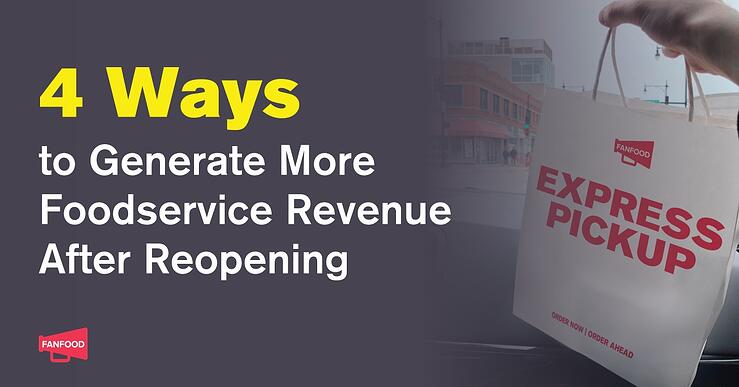4 Ways to Generate More Foodservice Revenue After Re-Opening
 At the time of writing, 38 states have (finally) announced that restaurants are allowed to open for dine-in; football season (hopefully) is still coming back this fall per the NFL’s latest announcement; and while future events may be (unfortunately) crowd-less, stadiums and arenas are already using parking lots as drive-in theaters for additional revenue.
Re-opening seems so close — one can almost feel it.
As operators gear up for customers returning, it’s important to first and foremost prioritize safety (you can check out our blog on how to manage coronavirus post lockdown). People are especially sensitive when it comes to the handling of food and beverages. There’s a looming question for foodservice operators in the restaurant, hospitality, sports and entertainment industries:
How do I generate more revenue despite social distancing after re-opening?
Well, we’re glad you asked.
At the time of writing, 38 states have (finally) announced that restaurants are allowed to open for dine-in; football season (hopefully) is still coming back this fall per the NFL’s latest announcement; and while future events may be (unfortunately) crowd-less, stadiums and arenas are already using parking lots as drive-in theaters for additional revenue.
Re-opening seems so close — one can almost feel it.
As operators gear up for customers returning, it’s important to first and foremost prioritize safety (you can check out our blog on how to manage coronavirus post lockdown). People are especially sensitive when it comes to the handling of food and beverages. There’s a looming question for foodservice operators in the restaurant, hospitality, sports and entertainment industries:
How do I generate more revenue despite social distancing after re-opening?
Well, we’re glad you asked.
1. Make the most out of takeout, delivery and curbside pickup.
What do Tibbs Drive-in Theater, Flash Taco food truck, the Dubai Mall and SLS Lux Brickell hotel have in common? They are all taking advantage of contactless and curbside pickup (yes, with FanFood’s online and mobile ordering platform!) In a recent interview, Danny Meyer, CEO of Union Square Hospitality Group and founder of Shake Shack, said that economically restaurants can’t sustain themselves below 80% capacity — let alone below the recommended capacity of 50% for social distancing. Even as COVID-19 restrictions are reeled back this summer, takeout and delivery will remain as crucial revenue streams. Whatever the type and size of your F&B operation, there’s always a way to get to your customers, and COVID-19 can’t stop you. In Chicago, food trucks like Flash Taco are partnering with FanFood to directly serve residential buildings. Tenants can pre-order on FanFood for scheduled pickup when the food truck arrives, or order instantly while it’s parked downstairs.Cityfront Place apartment tenants pre-ordering on FanFood from Flash Taco Food Truck.
Curbside pickup is all the rage now. From drive-in theaters and stadiums all the way to shopping malls, any kitchen can offer curbside pickup. Within the FanFood app, customers can even enter their car make and plate number to facilitate curbside pickup. In-store contactless pickup is also an option. The perk of having online and mobile ordering like FanFood is that the whole process is made effortless — no more lengthy phone calls and misheard order details.2. Adjust your menu to include family meals, meal kits and grocery items.
One trend we’ve observed during the pandemic is a pivot in menu offerings. For example, Meyer mentioned that restaurants traditionally rely on private events and celebrations as a key source of revenue. Without that being a possibility anytime soon, some businesses are offering family meals with multiple portions in lieu of individual entrees. A whole pan of lasagna, a large salad, a giant tray of desserts…not only are your customers set for a few days with the leftovers, but also help you save on packaging and earn more with larger orders. Another option is offering meal kits or meal prep services. One of FanFood’s partners, O’Bar Cafe in Illinois, is offering meal prep services for curbside pickup. You can also offer meal kits of only ingredients, and host live virtual cooking classes that teach your customers how to make those meals, as what these restaurants are doing in Atlanta. Some restaurants and food trucks are even directly selling their leftover inventory, from milk and eggs to fruits and cooking oil. The good news is, no matter how you want to reinvent your menu during this crazy time, a mobile ordering platform allows you to quickly adjust individual items, pricing and stock so that your customers get the most updated information instantly.3. Give your customers the peace of mind so they feel safe to make purchases.
In an interview with The Atlantic, chef and restaurateur Tom Colicchio suggested reducing physical interactions between staff and customers through online ordering before arrival. Steve Salis, a restaurant owner in Washington, D.C., recommended omnipresent hand wipes and nearby portable sinks next to the tables (or in a stadium or arena setting, near every section) so people can get up and wash their hands more often. Salis also suggested removing excess furniture, which makes the space easier to clean and sterilize. The following graph was published by Guangzhou Center for Disease Control and Prevention in China when investigating how an asymptomatic member of a family of five infected 10 out of 80 customers in the restaurant. People along the pathway of the old air from the AC on the right were infected, the rest were not. The verdict? It seemed that the vector of transmission wasn’t food, hard surfaces, or any matter of human touching, but air.
A floor plan of restaurant tables and air-conditioning flow at the site of a coronavirus outbreak in Guangzhou, China. The yellow circle indicates an infected patient; red circles show future patients. (Courtesy of the Centers for Disease Control and Prevention)
You’ve probably already seen, or implemented, measures to prevent something like that from happening: having all staff members wear face masks and gloves at all times, putting up barriers between tables / sections, or moving the entire dine-in experience outdoors. The truth is, all these visible measures aren’t only keeping your guests safe, but also subconscious reassurance that tells them: “It’s ok. It’s safe to come here and get a meal.”4. Don’t overlook digital marketing and customer engagement.
Business won’t come to you unless you spread the word around. That’s especially true when you try to get a speedy recovery. A good rule of thumb is: over-communicate. Use social media, email, your website, or anywhere your customers might look to share your hours, open locations, special offers, delivery platforms, safety measures…you name it. And most importantly, tell your customers — how every order is helping you to keep business running (including keeping your employees hired and sustaining through this difficult phase), and thank them for their unwavering support. Here’s a creative example for that: FanFood’s partner Skyline Drive-in theater made this entertaining video telling their customers to use FanFood when ordering concessions before and during the show. When it comes to customer engagement, one great tactic is promoting gift cards. This is a quick way to get cash now and only serve the customers when things start to get better. Besides, on average, gift card redemption is only about 80%, so definitely take advantage of this tactic whether you run a restaurant, food truck or a concession stand.

